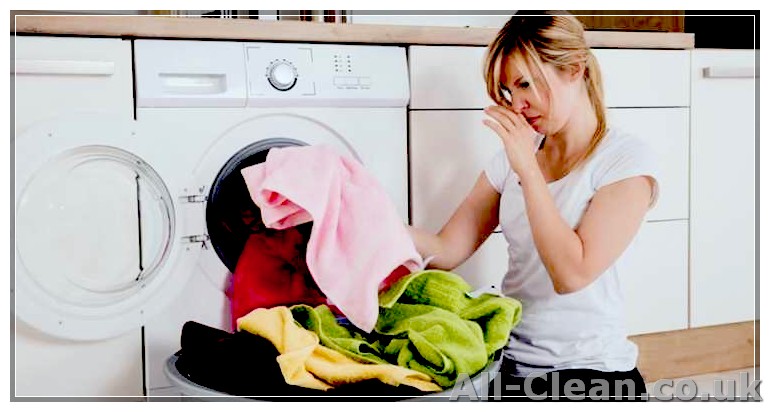
If you notice a musty smell or mold buildup in your washing machine, it’s important to address it as soon as possible. Neglecting the cleanliness of your machine can lead to the buildup of bacteria and unpleasant odours. Fortunately, there is an easy method to effectively clean your machine and banish any harmful elements.
To start, you should empty and wipe down the drum of your washing machine using a damp cloth. Make sure to remove any objects or lint that may have accumulated in the drum or filter. Next, check the detergent drawer and the areas around it for any residue or mold. You can use a brush to scrub away any stubborn stains or buildup.
Once the visible areas are clean, it’s time to tackle the hidden parts of the machine that often go unnoticed. One such area is the rubber door seal. This area is prone to mold and bacteria growth due to the dark and damp environment. Using a mixture of warm water and a cleaning agent, gently scrub the seal to remove any mold or bacteria. Be sure to pay special attention to the folds and crevices where mold tends to hide.
In addition to the rubber seal, the detergent drawer should also be cleaned thoroughly. Remove the drawer and wash it separately with warm soapy water. Use an old toothbrush or a brush with bristles to reach the hard-to-reach areas. Slide the drawer back in place once it is clean and dry.
To ensure that your machine is cleaned properly, you should also clean the filter, which is often located at the bottom of the machine. Follow the manufacturer’s instructions to access the filter and remove any debris or objects that may have accumulated. Cleaning the filter regularly will help prevent clogs and ensure that the machine drains properly.
Finally, run an empty cycle with a drumclean or a similar cleaning product. This will help eliminate any remaining bacteria and odours that may still be present. You can find these products in most supermarkets or purchase them online. Always read the instructions on the product label and follow them carefully.
By following these simple steps, you can ensure that your washing machine is clean and free from mold, bacteria, and odours. Regular cleaning is essential to maintain the efficiency and longevity of your machine. By incorporating this cleaning routine into your general household cleaning, you will be able to enjoy fresh-smelling and perfectly clean laundry every time.
Cleaning the Detergent Drawer

The detergent drawer is an essential part of your washing machine, where you add detergent and other laundry products. Over time, it can accumulate dirt, mould, and bacteria, which can cause unpleasant odors and affect the cleanliness of your laundry.
To keep your detergent drawer clean and fresh, follow these simple steps:
- Empty the drawer: Start by removing the detergent drawer from the washing machine. Depending on your machine, this may involve pressing a release button or pulling it out.
- Clean the main drawer: Take out all the different compartments of the drawer and clean them thoroughly. Use warm water and a small brush to scrub away any residue or leftover detergent. Be sure to remove any built-up mould or mildew.
- Slide out the drawer: Slide the drawer out until you have full access to the space behind it. This area can be a haven for mould and bacteria, so give it a good clean with warm soapy water and a brush.
- Wash the drawer: Take the cleaned drawer to your kitchen sink and give it a final wash with warm water and soap. Pay special attention to any built-up detergent or grime.
- Dry the drawer: Once the drawer is clean, give it time to air dry completely. This will prevent any lingering moisture that could lead to mould growth.
- Replace the drawer: Once the drawer is dry, slide it back into its original position in the washing machine. Make sure it is fully seated and secure.
By regularly cleaning your detergent drawer, you can banish unpleasant odors and ensure that your washing machine functions at its best. Remember to follow these steps whenever you notice a musty smell or build-up in the drawer.
For more tips on how to clean your washing machine, check the manufacturer’s instructions or download a detailed cleaning guide from the manufacturer’s website. It is generally recommended to run a self-cleaning cycle every few months and to regularly clean the filter and other parts of the machine.
How Often Should You Clean a Washing Machine?
Regular cleaning of your washing machine is essential to ensure its proper functioning and to eliminate any mould, bacteria, and odours that may accumulate over time. The frequency at which you should clean your washing machine depends on various factors, including usage, water hardness, and the type of detergent you use.
Generally, it is recommended to clean your washing machine every 2-3 months to maintain its cleanliness and efficiency. However, if you notice any signs of mould, mildew, or unpleasant smells, it is crucial to clean your washing machine as soon as possible.
Here are some signs that indicate it’s time to clean your washing machine:
- The drains are clogged or slow to empty.
- You notice a build-up of soap scum or debris in the filter.
- There is a strong smell coming from the machine, indicating the presence of bacteria or mould.
- The detergent drawer or slide is covered in residue or mould.
- There are visible stains or marks on your clothes after washing.
When cleaning your washing machine, it is essential to use a suitable cleaning agent specifically designed for this purpose. There are various options available online or at your local store, ranging from self-cleaning tablets to liquid cleaners. Always read and follow the instructions provided by the manufacturer to ensure the best results.
Here are some general steps to clean your washing machine:
- Empty the washing machine and remove any clothes or items.
- Wipe down the interior and exterior surfaces of the machine using a damp cloth and a mild detergent.
- Check the detergent drawer and filter for any residue or mould and clean them thoroughly.
- Inspect the rubber seal around the door for any mould or dirt and clean it with a suitable cleaning agent.
- Run a cleaning cycle or a hot water cycle with a washing machine cleaning agent to remove any remaining bacteria, mould, or odours.
- After the cleaning cycle, wipe down the interior surfaces of the machine again and leave the door open to allow it to dry thoroughly.
By following these steps and cleaning your washing machine regularly, you can ensure its longevity, efficiency, and cleanliness. A clean washing machine will help prevent damage to your clothes and remove any bacteria or odours, allowing your clothes to come out fresh and clean every time.
Cleaning Your Filter

One of the most important parts of maintaining a clean and odor-free washing machine is cleaning the filter. The filter in your washing machine plays a vital role in trapping dirt, debris, and other particles that may be present in your clothes or in the water used for washing.
Over time, the filter can become clogged with lint, hair, and other materials, which can impact the performance of your machine. If your washing machine runs for longer than usual or you notice a decrease in its efficiency, it may indicate that your filter needs cleaning.
Cleaning the filter of your washing machine is a helpful and easy task that you can do yourself. Here’s how to do it:
- Before cleaning the filter, make sure your washing machine is turned off and unplugged to avoid any accidents.
- Locate the filter, which is usually found at the bottom of the machine. Refer to your machine’s user manual for the exact location.
- Place a towel or a small container under the filter to catch any water that may come out when removing it.
- Open the filter compartment and remove the filter from its housing. It’s often a good idea to wear gloves, as the filter may be dirty or contain bacteria.
- Clean the filter by running it under warm water and gently wiping away any dirt or debris. Use a soft brush or toothbrush to remove any stubborn residue.
- Inspect the filter for any damages or leaks. If you notice any cracks or leaks, you may need to replace the filter.
- Once the filter is clean and in good condition, place it back into its housing and secure it properly.
- Make sure to clean the filter regularly, ideally every three to six months, depending on how often you use your washing machine. Regular filter cleaning helps maintain the cleanliness and efficiency of your machine.
Remember, cleaning your filter is just one part of proper washing machine maintenance. It’s also important to keep the drum, drawers, and other relevant areas clean and free from mold or bacteria. Using a dedicated cleaning product for washing machines can be a great option to ensure everything is in perfect condition without any unpleasant smells or leaks.
By following these tips and regularly cleaning your filter, you can ensure that your washing machine functions properly and your clothes come out fresh and clean every time!
Cleaning the Drum

One of the most important parts of cleaning your washing machine is making sure that the drum is free from mould, bacteria, and odours. Over time, these can build up and affect the cleanliness of your laundry, as well as the performance of your machine. Follow these steps to clean the drum of your washing machine:
- Prepare the machine: Start by turning off the power and unplugging the machine. Open the door and remove any laundry or other items from the drum.
- Wipe the drum: Use a damp cloth or sponge to wipe the inner surface of the drum. Make sure to clean all areas, including the back and sides. Pay extra attention to any visible stains or mould spots.
- Clean the detergent drawer: Remove the detergent drawer and wash it with warm soapy water. Use a small brush or toothbrush to scrub away any residue or build-up. Rinse it thoroughly and let it dry before placing it back in the machine.
- Clean the rubber seal: The rubber seal around the door is a common place for mould and dirt to accumulate. Use a cloth soaked in a mixture of water and vinegar to wipe the seal. Pay attention to the folds and crevices, as they can trap dirt and mould.
- Check the filter: Some washing machines have a filter that needs to be cleaned regularly. Consult your machine’s manual or check online for instructions on how to locate and clean the filter. This will help prevent clogs and keep your machine running smoothly.
- Run a self-cleaning cycle: Many modern washing machines have a self-cleaning cycle that can help remove any remaining residue or odours. Follow the instructions in your machine’s manual to run this cycle. If your machine does not have a self-cleaning cycle, you can run a hot water cycle with a cup of white vinegar to achieve a similar effect.
- Wipe the exterior: Finally, wipe down the exterior of the machine with a damp cloth. Pay attention to any buttons or control panels, making sure to clean them thoroughly.
Cleaning the drum of your washing machine is an essential maintenance task that should be done regularly. By following these steps, you can keep your machine looking and smelling fresh, and ensure that it functions at its best for years to come.
Related Articles
Here are some articles related to cleaning and maintaining your washing machine:
- Cleaning the Washing Machine Seal: Learn how to clean the rubber seal around the door of your washing machine to prevent mold and bacteria buildup.
- How to Clean Your Washing Machine Drawer: A step-by-step guide on how to remove and clean the detergent drawer of your washing machine to ensure optimal cleanliness.
- Top Tips for Cleaning Your Washing Machine Drum: Discover the best methods for cleaning the drum of your washing machine, eliminating dirt, bacteria, and odors.
- Regular Maintenance for your Washing Machine: Find out why regular maintenance is important, including cleaning the filters and drains, to ensure your machine remains in good condition.
- Self-Cleaning Washing Machines: Learn about the self-cleaning options available in some washing machines and how they can help keep your machine clean and fresh.
- Choosing the Right Cleaning Products for Your Washing Machine: A comprehensive guide to selecting the right cleaning products for your machine to keep it in top condition.
- How to Clean the Exterior of Your Washing Machine: Tips and tricks for keeping the outside of your washing machine clean and free from dirt and smudges.
- Maintaining a Clean Washing Machine: Recommendations from the Manufacturer: Check your machine’s user manual or visit the manufacturer’s website for specific cleaning instructions and recommendations.
- Professional Cleaning Services for Washing Machines: Explore the option of hiring professional cleaning services to give your washing machine a deep clean and prevent any potential issues.
By following these related articles, you can ensure that your washing machine stays clean, in good condition, and free from any odours or bacteria.








